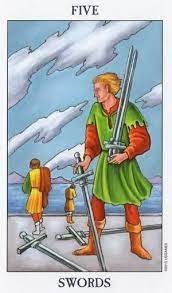
As you’ve figured out by now, the Five of Swords has several layers, and it all depends on what position you are in. So let’s figure out how to make conflict work for you so that you can ensure that it leads to positive rather than negative changes in your life. First, let’s introduce a few basic ideas: wins and losses represent part of the human experience and can provide major keys to self-improvement.
You’re Still Alive!
Recognize that you can’t win every struggle, that defeat is part of life, and that the good news is you’re still alive. Next, know that a conflict’s outcome can teach you a lot about yourself, including your actual life priorities. How do you make that happen? Read on…
Working intuitively with tarot cards using my tarot coach approach is an excellent place to sharpen your skills, increase your intuition, and discover your answers. Once you get the hang of how it works, you can use it repeatedly to help navigate your way through life’s many dilemmas.
The Tarot Coach Approach to Solving Conflicts
- First, ask a question about conflict, such as “how can I better handle a current conflict in my life?”
- Now let your eyes sweep over the Five of Swords card and jot down the image to which you are most drawn. Let’s say it’s those sharp clouds.
- Next, what color catches your attention? Maybe it’s the prominent figure’s green tunic.
- Finally, what’s the overall vibe you get from this card? Perhaps it feels tense.
Putting It All Together
Sharp Clouds: These lightning bolt-type clouds can represent your sudden awakening to the harsh reality that a particular situation is causing conflict. Alternatively, they may point to a lack of emotion.
Green tunic: Green promotes change and mature growth; it governs the heart chakra, which deals with love, higher consciousness, and awareness of the role you’re playing.
Tension: Whatever the conflict, the situation is a tense one. And when we’re tense, we’re usually not at our best. With our muscles clenched and teeth gritted, we generally prepare for the other shoe to drop or for a battle.
Let’s put the above together:
Question: “How do I make this conflict work for me?”
Answer: I’m tense because I don’t understand the true nature of this conflict. Perhaps a new perspective on my role will allow me to feel self-compassion and have more compassion for others. Maybe it can help change my outlook and reduce or eliminate my anger.
Now, try this exercise:
1) Choose what stands out the most to you on the card.
2) Apply your associations with the object, color, and overall vibe you feel most relevant.
3) Put them together in a sentence and ask yourself: What was my part in this conflict? How can I best resolve it in the most mature way possible that allows me to either enjoy my victory or recognize when it’s time to disengage and walk away?
Do you find you always need to be right? Do you find it exhausting always to be right? Don’t miss next week’s blog: When Losing is Winning. You’ll learn how conflicts are lost and won—and when you should simply walk away.
Ever upward!

 Spooky Season is Here! Events are Happening!
Spooky Season is Here! Events are Happening!There’s still time to plan and create your ideal party!




… and don’t forget the tarot readings!





